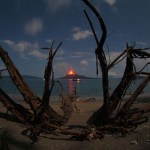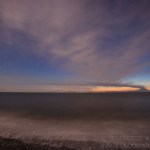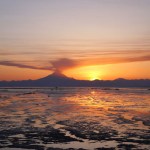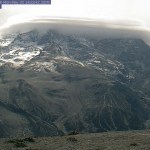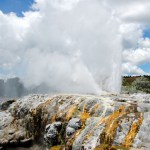Alaska
Not much new to report today, so I'll just add some notes to the two volcanoes in the news right now: Mayon and Redoubt.
Mt. Redoubt in Alaska, taken on September 23, 2009. Image courtesy of AVO/USGS, taken by Game McGimsey.
Mayon:
The volcano continues to show signs that a major eruption is in the works, but nothing new occurred over the last 24 hours. 2 km / ~5,000 foot ash plumes were produced from the new dome/flow complex, causing a potential aviation hazard, and the lava flows continued to be erupted. In evacuation news, animals are now being evacuated from the hazard zone around the…
The most recent image on the AVO website of the dome at Redoubt, taken in November 2009. Image courtesy of AVO/USGS, by Cyrus Read.
Not much information on this, but AVO just raised the alert status at Redoubt in Alaska to Yellow for the first time since late September. A series of small earthquakes were detected near the summit dome starting at 10 A.M. today, prompting the change of status.
The link to the complete text of the change in status doesn't seem to work on the AVO site, so here it is:
2009-12-28 09:53:11 - VAN/VONA
AVO is raising the Aviation Color Code to YELLOW and the Volcano…
I did an excellent job of forgetting my notes from GSA 2009, so no wrap up on the meeting until tomorrow, but we do have some new volcano news to digest:
The crater of El Reventador in Ecuador in an undated photo.
Ecuadorian officials have called for evacuations around El Reventador. The Ecuadorian Geophysics Institute says that the volcano's "activities were measured at a level considered high, with permanent seismic signals indicating explosions while the southern side of the volcano crater could be seen as incandescent.". Three provinces near the volcano were put on alert evacuated as a…
And not because the Indians' season is finally (mercifully) over (zing!)
Cleveland steaming away in a 2008 AVO image.
Cleveland (the volcano) erupted on Friday, producing an ash column that reached 4.5-6 km / 15,000-20,000 feet. The full report from AVO:
Satellite data indicate that Cleveland volcano erupted briefly this morning at ~0730 UTC (2330 AKDT) 02 October 2009, producing a small, detached ash cloud that drifted northeast of the volcano at maximum altitudes of 15,000' to 20,000' (4.5 - 6.1 km) .
AVO has no real data seismic data right now for Cleveland, so only satellite imagery…
The big geology news right now is the M8 earthquake in American Samoa that generated a killer tsunami (which made it all the way to the Bay Area in California).
Mammoth Mountain in California's Long Valley region.
In more benign, volcano-related news:
The aviation alert level at Redoubt in the Alaska has been returned to Green/Normal, which means that for all intents-and-purposes, the eruption that started earlier this year is over. The new dome totals ~91 million cubic yards of lava, slowly adding back to the north side of the volcano.
Eruptions reader Doug C. pointed out to me that there…
Some brief tidbits for your Wednesday:
The view of Mt. Saint Helens from the Johnston Ridge Observatory.
There is a decent article about research being done at a dissected caldera system in the Italian Alps' Sesia Valley. The caldera in question is the Permian in age (248-298 million years old) so don't expect to find it in the GVP database, but the outcrops of this ancient caldera are especially well exposed, allowing for a cross section of volcano and plutonic rocks across 25 km of crustal depth (all of which is now at the surface thanks to hundreds of millions years of tectonics). It…
Some brief notes before I dive headlong into the exciting world of faculty orientation!
A small steam plume coming from Turrialba in Costa Rica. Photo taken in August 2007.
There are some preliminary reports of the state of wildlife (and everything) around Kasatochi Island in the Aleutians from the US F&W and USGS team that headed to check out how the island has recovered since last year's eruption. The shoreline has been radically transformed by the ash and although some seabirds have made attempts to nest in the loose ash, it doesn't seem to have been very successful. However, not…
I knew that the minute I said I'd be back to a "regular" posting schedule that I would fail miserably, so maybe the less said, the better.
Cerro Galan caldera in Argentina (taken from space).
Thanks to all the readers who have been avidly discussing a number of fascinating topics over the weekend.
I have seen/read a little bit about the tectonic-forcing mechanism idea for some caldera-style eruptions. The biggest thing to keep in mind is that the caldera-forming event - that is to say the collapse of the roof into the chamber - isn't usually the "trigger" as much as a result of a large…
Does anyone else feel like this has been a rather quiet summer, volcano-wise? Maybe I've been too preoccupied by my move to Ohio, but I feel like beyond a few relatively minor events (Shiveluch comes to mind), the volcano news has been pretty slow compared to the spring of this year. Go figure.
The sulfur dioxide plume from the 2008 eruption of Kasatochi spreading over the northern Pacific Ocean.
Anyway, a few tidbits to tide us over:
Over eighteen years after the eruption, Mt. Pinatubo is still causing fatalities from the copious amounts of tephra deposited during the 1991 event. Five…
Shishaldin volcano in Alaska.
Yesterday I mentioned in the SI/USGS Weekly Report update that things appear to be afoot at Shishaldin in the Aleutians. Well, I checked the Shishaldin webicorder today and indeed, [SPECULATION] something seems suspect. Now, the increasing signal might be wholly unrelated to any magmatic activity, but it is interesting to see an increase in the seismicity after the increase in the intensity of thermal anomaly at the summit crater.
AVO's latest statement (from yesterday) seems to think that nothing too much is up:
Cloudy conditions prevented views of Shishaldin…
Your weekly dose of volcanism from the USGS/Smithsonian Global Volcanism Program.
Highlights (not counting Mayon), include:
The activity at Mando Hararo in Ethiopia appears to be a fissure eruption. Ground observations saw a 4-5 kilometers / ~2.5-3 mile fissure with new predominantly 'a'a lava flows that were 2-3 m thick ... the fissure was lined with scoria ramparts 30-50 m high. They did not see any active lava, though.
As some Eruptions readers have pointed out from the OMI SO2 maps, Sarychev Peak (Russia) is still producing gas-and-steam (with some ash) plumes, mostly drifting off to the…
Anak Krakatau erupting as seen from Rataka Island. Image taken by Marco Fulle of Stromboli Online.
I frequent the Astronomy Picture of the Day website run by NASA on a daily basis. Yet somehow today I didn't check the site until well into the evening and was greeted by one of the best astronomy-volcano images I've seen in a while. Marco Fulle of Stromboli Online captured this image of Anak Krakatau erupting (in 2008 or 2009 ... its unclear in the caption) with Ursa Major rising over the volcano. There have been quite a few volcano-related images on APOD, but alas, they don't have a "volcano…
Another fun weekend for me analyzing zircon on the SHRIMP-RG at Stanford University! I really know how to live it up during the summer.
Some news bits:
The 2009 dome at Redoubt in Alaska steaming on July 2, 2009. Image taken by Cyrus Read, courtesy of USGS/AVO
In another sign that Redoubt's 2009 eruption might be at an end, AVO has ceased 24 hour staffing of their operations center. They still warn that Redoubt might still have more activity up its sleeve, but as of now, things are pretty quite. The latest update on Redoubt reports that the new dome continues to steam away and seismicity…
Redoubt steaming in early 2009. Image courtesy of Calvin Hall.
It has been a while since we spoke of Redoubt, but now it seems the reason why might be that the eruption is ending. AVO lowered the Alert Level at Redoubt to Yellow from Orange, indicating that they believe the volcano is less likely to have a large eruption. This doesn't mean that it is out of the question, but rather that signs seem to be pointing to the idea that the eruption is waning.
AVO sums the change:
Seismic, satellite, gas, and deformation observations over the past few weeks indicate that growth of the lava dome at…
The Q&A post will be coming over the weekend (there's still time to send me a question!)
Icy cold volcanoes (well, geysers) on Enceladus, a moon of Saturn.
In the meantime, here are a few quick hits:
Mt. Cleveland in the Aleutians had a small eruption. The plume was only ~15,000 feet / ~3 km. Cleveland is one of the more active volcanoes in the Aleutians, so this eruption is not out of the norm.
Landslides and rockfalls at Arenal (in spanish) in Costa Rica continue to prompt evacuations of tourists near the volcano. It is interesting to note that officials don't seem worried about hotel…
A few quick news bits ... and thanks for the questions so far. Keep 'em coming!
Tungurahua, Ecuador erupting in 2006.
Ash fall from Tungurahua (in spanish) in Ecuador is affecting the farm towns around the volcano. Farmers in Manzano, a village nearby, fear the ash is significant enough to damage their crops. The volcano itself is throwing incandescent bombs near the vent along with producing copious ash.
There is a nice piece in the News Tribune about how Alaska Airlines handled the eruption of Mt. Redoubt near Anchorage this March. It is nice to get some insight into how airlines deal…
This will likely be my last new post for the next week or so. I'll be off to my home town for a wedding and a reunion. If you're jonesing for up to date volcano info, be sure to visit the Volcanism Blog or the European Volcanological Society news page. Feel free to post any other links you know or breaking volcano news over on the open thread as well! I will be posting a couple pieces over this next week, including the next volcano profile, so stay tuned for those as well. Regular posting of new volcano news should return June 15.
Mt. Redoubt in Alaska steaming in spring 2009. Image courtesy…
Redoubt steaming away on May 4, 2009. Image courtesy of AVO/USGS
Fairly quiet weekend (except for the start of the College World Series regionals ... I do have a favored team*), volcanically speaking, but the ever-vigilant folks up in Alaska are keeping an eye on Redoubt as the eruption of 2009 continues.
The weekly status (released 5/29) for Redoubt released by AVO has no big surprises, reporting that "small discrete earthquakes and rockfall signals in the summit region have been recorded steadily over the course of the past week. In other words, the dome continues to extrude and part of it…
Lenticular clouds forming over Redoubt on May 25, 2009. Image courtesy of AVO/USGS and sent to me by Eruptions reader Todd Russell.
We haven't talked much about Redoubt lately, so I thought I'd add a brief update. First off, the Alert Level at the volcano still sits at Orange/Watch status, meaning that although the volcano is not erupting, it could at almost any time.
Most of the threat of eruption stems from the ever-growing lava dome on the volcano. AVO noted today that the "Hut webcam views today show evidence of recent rockfall activity, including a fresh ash deposit to the east (left)…
Pohutu Geyser in Rotorua, New Zealand. Image taken by Erik Klemetti in January 2009.
It has been busy busy week for me, capped off today with a talk about my field work in New Zealand (see above), so I don't have much to say. Not much new news today about the Saudi Arabian earthquake swarms, but again, I'll keep my eyes pealed (incidentally, I still haven't been able to figure out why no western news sources have even mentioned the swarm).
Anyway, here's are some volcanic tidbits to enjoy over the long weekend:
Vog, as seen from space. Volcanic fog, fashionably shortened to "vog" is a real…
